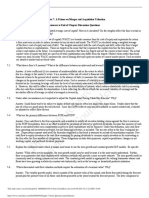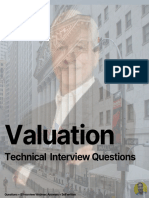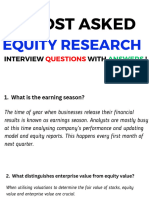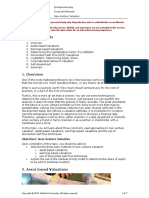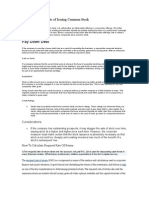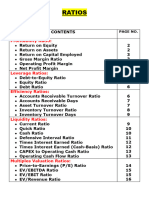0 ratings0% found this document useful (0 votes)
4 viewsInvestment Banking Interview Questions 1695196425
Investment Banking Interview Questions 1695196425
Uploaded by
Drishti ChopraCopyright:
© All Rights Reserved
Available Formats
Download as PDF, TXT or read online from Scribd
Investment Banking Interview Questions 1695196425
Investment Banking Interview Questions 1695196425
Uploaded by
Drishti Chopra0 ratings0% found this document useful (0 votes)
4 views14 pagesCopyright
© © All Rights Reserved
Available Formats
PDF, TXT or read online from Scribd
Share this document
Did you find this document useful?
Is this content inappropriate?
Copyright:
© All Rights Reserved
Available Formats
Download as PDF, TXT or read online from Scribd
Download as pdf or txt
0 ratings0% found this document useful (0 votes)
4 views14 pagesInvestment Banking Interview Questions 1695196425
Investment Banking Interview Questions 1695196425
Uploaded by
Drishti ChopraCopyright:
© All Rights Reserved
Available Formats
Download as PDF, TXT or read online from Scribd
Download as pdf or txt
You are on page 1of 14
Investment Banking
Technical Interview
Questions.
Source: CFI, The Valuation School, Investopedia, YouTube, Etc.
01
Q. How do you value a company?
Intrinsic Value (DCF):
The DCF says that the value of a going concern company
is equal to the present value of its future cash flows.
We have to find the company’s free cash flows to firm for
5-20 years, depending on the availability and reliability of
the information, and then calculate a terminal value.
A growth rate is added to the FCFF. The factors to
consider here are previous growth, business cycle, macro
factors, company’s potential, Analyst’s estimate and Top
down approach.
Discount both the FCFFs projections and terminal value
by an appropriate cost of capital which is weighted
average cost of capital. (10yr Govt Bond Yield - Default
Spread + ERP * Beta)
In an unlevered DCF this will yield the company’s
enterprise value (aka firm and transaction value), from
which we need to subtract net debt to arrive at equity
value.
To arrive at the equity value per share, divide the equity
value by the company’s diluted shares outstanding.
02
Relative Valuation:
Comparable Company (Multiples):
It involves determining a comparable peer group –
companies that are in the same industry with similar
operational, growth, risk, and return on capital
characteristics.
Truly identical companies of course do not exist, but
you should attempt to find as close to comparable
companies as possible. Calculate appropriate industry
multiples.
Apply the median of these multiples on the relevant
operating metric of the target company to arrive at a
valuation.
Common multiples are EV/Rev, EV/EBITDA, P/E, P/B,
although some industries place more emphasis on
some multiples vs. others, while other industries use
different valuation multiples altogether.
03
Comparable Transaction:
The valuation is based on any a Similar and
Comparable company which is sold in the near term.
The comparable company must be in the similar
business sector and the size of the company should be
relevant
We have to check the valuation metric, Whether it is
relevant in today’s dynamics or not.
Selling Company - Similar & Comparable to match the
size and the business sector.
Buyer - Must be a public company or else you wont
have any deal information.
% of Stake - The stake must be >50% hence the
acquisition.
04
Q. Tell me about a particular industry you
are interested in and the how will you
value it?
Do prepare a research report and a financial model for
a company to go deep in the business and the industry.
You will learn a lot about the macroeconomic factors
and the company’s business model.
Do research about an industry or two (read an industry
report by a sell-side analyst) before the interview.
Pick the industry about which you are genuinely
interested in and which is easy to understand.
Read one or two year of Annual report and 2-3 Con
Calls of the company to go deep.
This will give you a lot of things to talk about the
industry and the company, And then explain the
valuation using any method (Go DCF).
Be reasonable and logical with your reasons behind the
numbers specifically Growth Rate.
05
Q. What is the appropriate discount rate
to use in an unlevered DCF analysis?
Since the free cash flows (FCFF) in an unlevered DCF
analysis are pre-debt (Think as unlevered cash flows as
the company’s cash flows as if it had no debt – so no
interest expense, and no tax benefit from that interest
expense),
The cost of the cash flows relate to both the lenders
and the equity providers of capital.
Thus, the discount rate is the weighted average cost of
capital to all providers of capital (both debt and equity).
Cost of Debt: The cost of debt is readily observable in
the market as the yield on debt with equivalent risk
reducing the country and company (If emerging)
default spread.
Cost of Equity: The cost of equity is typically estimated
using the capital asset pricing model (CAPM), which
links the expected return of equity to its sensitivity to
the overall market but do take the country equity risk
premium into consideration too.
06
Q. What is typically higher – the cost of
debt or the cost of equity?
The cost of equity is higher than the cost of debt
because the cost associated with borrowing debt is
less since they are taking less risk while giving out the
capital hence the lower return.
The equity shareholders took a lot more risk while
investing hence the higher return.
Also the interest expense is tax-deductible, creating a
tax shield which further reduces the cost of debt..
Additionally, the cost of equity is typically higher
because, unlike lenders, equity investors are not
guaranteed fixed payments, and are last in line for
liquidation.
07
Q. How do you calculate the cost of
equity?
There are several competing models for estimating the
cost of equity, however, the capital asset pricing model
(CAPM) is predominantly used on the street.
The CAPM links the expected return of a security to its
sensitivity to the overall market basket (often proxied
using the S&P 500 or Nifty 50).
CAPM Cost of Equity (Ke) = Risk Free Rate (rf) + β x
Market Risk Premium (rm-rf ).
Risk Free Rate: It should reflect the YTM of default-free
government bonds of equivalent maturity to the
duration of each cash flows being discounted.
Market Risk Premium: MRP (rm-rf) represents the
excess returns of investing in stocks over the risk-free
rate.
Beta (β): It provides a method to estimate the degree of
an asset’s systematic (non-diversifiable) risk. It means
the risk in investing in a company instead of the market.
Beta of 1.0 is “as risky” as the overall stock market.
08
Q. How would you calculate β (Beta) for a
company?
Calculating raw betas from historical returns and even
projected betas is an imprecise measurement of future
beta because of estimation errors (i.e. standard errors
create a large potential range for beta).
It is recommended that we use an industry beta. Of
course, since the betas of comparable companies are
distorted because of different rates of leverage, we
should unlever the betas of these comparable
companies as such:
β Unlevered = β(Levered) / [1+ (Debt/Equity) (1-T)]
Then, once an average unlevered beta is calculated,
relever this beta at the target company’s capital
structure:
β Levered = β(Unlevered) x [1+(Debt/Equity) (1-T)]
09
Q. How do you calculate unlevered free
cash flows for DCF analysis?
The Unlevered FCF for DCF means the The firm’s cash
flows that is available for all the capital investors
whether debt or equity.
The formula for calculating the unlevered free cash flow
metric is as follows.
Unlevered Free Cash Flow = Operating Profit (EBIT) * (1
–tax rate) + Depreciation & Amortization – Change in
Net Working Capital – Capital Expenditures
10
Q. What is the appropriate numerator for
a revenue multiple?
It is Enterprise Value also the Market Cap. It is because
the revenue is earned on everyone’s money so the
numerator should be related.
The question tests whether you understand the
difference between equity value and enterprise value
and their relevance to multiples.
Equity value = Enterprise Value – Net Debt (Net Debt =
Gross Debt and Debt Equivalents – Excess Cash) +/-
Value in Subsidiary Company + Value of any Non
Operating asset.
Enterprise Value Multiples: EBIT, EBITDA, Unlevered
cash flow, and revenue multiples all have enterprise
value as the numerator because the denominator is an
unlevered (pre-debt) measure of profitability.
Equity Value Multiples: Conversely, EPS, after-tax cash
flows, and the book value of equity all have equity value
as the numerator because the denominator is levered –
or post-debt.
11
Q. How would you value a company with
negative historical cash flow?
Given that negative profitability will make most
multiples analyses meaningless, a DCF valuation
approach is appropriate here.
Q. When should you value a company
using a revenue multiple vs. EBITDA?
Companies with negative profits and EBITDA will
have meaningless EBITDA multiples.
As a result, Revenue multiples are more
insightful.
12
Q. Two companies are identical in
earnings, growth prospects, leverage,
returns on capital, and risk. Company A is
trading at a 15 P/E multiple, while the
other trades at 10 P/E. which would you
prefer as an investment?
We would prefer the company with P/E of 10. A
rational investor would rather pay less per unit of
ownership.
In PE of 15 you would have to 15 Rs for 1 Rs of
earning whereas with PE of 10 you will pay 10 Rs
for 1 Rs of earnings.
Posts every alternate Day Faizan Nezami
Want more cool insights?
Then Follow
You might also like
- Teuer Furniture B Case SolutionDocument43 pagesTeuer Furniture B Case SolutionShubham Gupta71% (7)
- Carter's LBO ModelDocument1 pageCarter's LBO ModelNoah100% (2)
- Cfi Business Valuation Modeling Final AssessmentDocument3 pagesCfi Business Valuation Modeling Final AssessmentKARTHIK100% (2)
- 2022 Nus Invest Responses & Stock Pitch ReportDocument12 pages2022 Nus Invest Responses & Stock Pitch ReportDev DesaiNo ratings yet
- Cash and Liquidity Management ConfigurationDocument43 pagesCash and Liquidity Management Configurationmike100% (2)
- Vagh's Guide PDFDocument50 pagesVagh's Guide PDFDownloadingeverydayNo ratings yet
- Chapter 7 Notes Question Amp SolutionsDocument7 pagesChapter 7 Notes Question Amp SolutionsPankhuri SinghalNo ratings yet
- M&A Case Competition: - Roche Acquisition of GenentechDocument19 pagesM&A Case Competition: - Roche Acquisition of GenentechJuan Diego Vasquez BeraunNo ratings yet
- Courseware Exhibits For Vodafone Airtouch'S Bid For Mannesmann Case No. N1-201-096 April 18, 2001Document16 pagesCourseware Exhibits For Vodafone Airtouch'S Bid For Mannesmann Case No. N1-201-096 April 18, 2001Shawn PantophletNo ratings yet
- Syllabus For NISM Research Analyst ExamDocument7 pagesSyllabus For NISM Research Analyst Examvignesh75% (4)
- How Do You Value A Company?Document3 pagesHow Do You Value A Company?Sumit DaniNo ratings yet
- Valuation Ft. 12 Interview QuestionsDocument12 pagesValuation Ft. 12 Interview Questionssubhashreddy3390No ratings yet
- Technical Interview Questions - MenakaDocument15 pagesTechnical Interview Questions - Menakajohnathan_alexande_1No ratings yet
- Interview Questions: Always Find A Link Between The StepsDocument9 pagesInterview Questions: Always Find A Link Between The StepsKarimNo ratings yet
- SOF Questions - With - AnswersDocument33 pagesSOF Questions - With - AnswersКамиль БайбуринNo ratings yet
- Equity Vs EVDocument9 pagesEquity Vs EVSudipta ChatterjeeNo ratings yet
- ACF Module 1 THEORY 29TH FebDocument10 pagesACF Module 1 THEORY 29TH FebRajesh KumarNo ratings yet
- Top 30 Investment Banking Interview Questions and AnswersDocument7 pagesTop 30 Investment Banking Interview Questions and AnswersVidit ParuthiNo ratings yet
- Where Do You See This?: What Does Leverage Mean?Document6 pagesWhere Do You See This?: What Does Leverage Mean?abhijeet1828No ratings yet
- Bav Notes Unit 3rdDocument10 pagesBav Notes Unit 3rdMrSURYAA pandeyNo ratings yet
- Valuation - DCFDocument38 pagesValuation - DCFKumar Prashant100% (1)
- Business Valuation ModelingDocument11 pagesBusiness Valuation ModelingAni Dwi Rahmanti RNo ratings yet
- Queen's - Interview GuideDocument87 pagesQueen's - Interview GuideGABRIEL SALONICHIOSNo ratings yet
- Valuation Final ReviewerDocument43 pagesValuation Final ReviewercamilleNo ratings yet
- EVA, MVA and SVA PrintableDocument20 pagesEVA, MVA and SVA PrintableBibek ShresthaNo ratings yet
- DCF in Depth Calculate The Revenue Growth Rate: Forecasting Free Cash FlowsDocument5 pagesDCF in Depth Calculate The Revenue Growth Rate: Forecasting Free Cash FlowsJustBNo ratings yet
- Investment SocietyDocument28 pagesInvestment SocietyFidias IeridesNo ratings yet
- Interview Questions - Consolidated-1Document51 pagesInterview Questions - Consolidated-1Abhineet NirvanNo ratings yet
- Equity Research Interview Questions 1691470588Document34 pagesEquity Research Interview Questions 1691470588cheekujangir1994No ratings yet
- Corporate Professionals Discounted Cash Flow Slideshare MondayDocument5 pagesCorporate Professionals Discounted Cash Flow Slideshare MondayCorporate ProfessionalsNo ratings yet
- What Does Capital Expenditure - CAPEX Mean?Document5 pagesWhat Does Capital Expenditure - CAPEX Mean?saber21chatterjeeNo ratings yet
- Discounted Cash FlowDocument50 pagesDiscounted Cash Flowgangster91No ratings yet
- Interviews Financial ModelingDocument7 pagesInterviews Financial ModelingsavuthuNo ratings yet
- Private Company ValuationDocument32 pagesPrivate Company Valuationakhil reddy kalvaNo ratings yet
- T5 WaccDocument35 pagesT5 Waccdavidbuk558No ratings yet
- New-Venture ValuationDocument7 pagesNew-Venture ValuationBurhan Al MessiNo ratings yet
- Session 7 Cost of CapitalDocument22 pagesSession 7 Cost of CapitalVishwa Deepak BauriNo ratings yet
- Weighted Average Cost of CapitalDocument20 pagesWeighted Average Cost of CapitalSamuel NjengaNo ratings yet
- Enterprise Value Vs Equity ValueDocument14 pagesEnterprise Value Vs Equity Valuecrazybobby007100% (1)
- Enterprise Value ThesisDocument6 pagesEnterprise Value ThesisPedro Craggett100% (2)
- Kellogg Valuation HelpDocument56 pagesKellogg Valuation HelpJames WrightNo ratings yet
- Equity Research Interview Questions and AnswersDocument22 pagesEquity Research Interview Questions and AnswersHarsh JainNo ratings yet
- Technical Interview Questions - IB and S&TDocument5 pagesTechnical Interview Questions - IB and S&TJack JacintoNo ratings yet
- 4-Limitations of Valuation Models PDFDocument41 pages4-Limitations of Valuation Models PDFFlovgrNo ratings yet
- Pay Down Debt: What Are The Benefits of Issuing Common StockDocument6 pagesPay Down Debt: What Are The Benefits of Issuing Common StockawaljanNo ratings yet
- Discounted Cash Flow ModelDocument21 pagesDiscounted Cash Flow Modelvaibhavsachdeva0326No ratings yet
- Bav Unit 4th DCFDocument57 pagesBav Unit 4th DCFRahul GuptaNo ratings yet
- 15 Financial RatiosDocument5 pages15 Financial Ratiosshrutikashyap29No ratings yet
- Financial Statements Analysis - Q&aDocument6 pagesFinancial Statements Analysis - Q&aNaga NagendraNo ratings yet
- RATIOSDocument16 pagesRATIOSantra10tiwariNo ratings yet
- Corporate Finance ProjectDocument13 pagesCorporate Finance ProjectAbhay Narayan SinghNo ratings yet
- Valuation 2021 DAMODARAN NotesDocument32 pagesValuation 2021 DAMODARAN NotesadityaNo ratings yet
- Intention To Create Legal RelationsDocument7 pagesIntention To Create Legal RelationsAlex MichaelNo ratings yet
- Bank Loans, Overdrafts, Lines of Credits, and Business Credit Cards. However, Most of Them AreDocument3 pagesBank Loans, Overdrafts, Lines of Credits, and Business Credit Cards. However, Most of Them Areisteaq ahamedNo ratings yet
- Financial Concepts: Weighted Average Cost of Capital (WACC)Document6 pagesFinancial Concepts: Weighted Average Cost of Capital (WACC)koshaNo ratings yet
- 25 Investment Banking Interview Questions (With Answers) - ForageDocument13 pages25 Investment Banking Interview Questions (With Answers) - ForageAdekunbi AduragbemiNo ratings yet
- WK - 5 - Cost of Capital Capital Structure PDFDocument40 pagesWK - 5 - Cost of Capital Capital Structure PDFreginazhaNo ratings yet
- Stock Market TermsDocument20 pagesStock Market TermsAbhijit ModakNo ratings yet
- Weighted Average Cost of CapitalDocument26 pagesWeighted Average Cost of CapitalAysi WongNo ratings yet
- If I Would Like To Protect My Downside, How Would I Structure The Investment?Document7 pagesIf I Would Like To Protect My Downside, How Would I Structure The Investment?helloNo ratings yet
- FSA - Commonly Asked Questions-2021Document27 pagesFSA - Commonly Asked Questions-2021Abhishek MishraNo ratings yet
- Ebit Revenue - Operating ExpensesDocument7 pagesEbit Revenue - Operating ExpensesArchay TehlanNo ratings yet
- Trading CompsDocument8 pagesTrading CompsLeonardoNo ratings yet
- American Greeting Case StudyDocument8 pagesAmerican Greeting Case Studyhchen0023No ratings yet
- Reinvestment PaperDocument15 pagesReinvestment PapermecontactyelNo ratings yet
- Equity Analysis Primer WhartonDocument37 pagesEquity Analysis Primer Whartonjiazhi93No ratings yet
- Ch09 3310Document16 pagesCh09 3310Muhammad AhmedNo ratings yet
- IPEV Valuation GuidelinesDocument70 pagesIPEV Valuation Guidelinestruyn cuoiNo ratings yet
- Chapter10 StudentworksheetDocument45 pagesChapter10 StudentworksheetMohitNo ratings yet
- Studying Different Systematic Value Investing Strategies On The Eurozone MarketDocument38 pagesStudying Different Systematic Value Investing Strategies On The Eurozone Marketcaque40No ratings yet
- CCS G4Document14 pagesCCS G4Harshit AroraNo ratings yet
- DCF Model - Power Generation: Strictly ConfidentialDocument5 pagesDCF Model - Power Generation: Strictly ConfidentialAbhishekNo ratings yet
- FinMan Module 4 Analysis of FSDocument11 pagesFinMan Module 4 Analysis of FSerickson hernanNo ratings yet
- Commonly Used Multiples in IndustryDocument24 pagesCommonly Used Multiples in IndustryRishabh GuptaNo ratings yet
- Asian Paints FinalDocument30 pagesAsian Paints FinalAdarsh NethwewalaNo ratings yet
- Valuation Exercise For FOS ENERGYDocument6 pagesValuation Exercise For FOS ENERGYAmr YehiaNo ratings yet
- Fundamental Equity Analysis & Analyst Recommendations - Insurance TitansDocument63 pagesFundamental Equity Analysis & Analyst Recommendations - Insurance TitansQ.M.S Advisors LLCNo ratings yet
- 03 BIWS Equity Value Enterprise ValueDocument6 pages03 BIWS Equity Value Enterprise ValuecarminatNo ratings yet
- Week 15 Risk ManagementDocument22 pagesWeek 15 Risk ManagementRay MundNo ratings yet
- Equity Valuation QuizletDocument12 pagesEquity Valuation QuizletEmiraslan MhrrovNo ratings yet
- Ross12e Chapter03 TBDocument20 pagesRoss12e Chapter03 TBhi babyNo ratings yet
- Day2 1Document111 pagesDay2 1Antariksh ShahwalNo ratings yet
- Comparable Companies TemplateDocument23 pagesComparable Companies Templatesandeep chaurasiaNo ratings yet
- Industry Multiples in India Report 2023 21st EditionDocument107 pagesIndustry Multiples in India Report 2023 21st Editionvkiran_1989No ratings yet
- Corporate Valutation 5ed - Study HelpDocument31 pagesCorporate Valutation 5ed - Study HelpzyndicateNo ratings yet
- Investment Banking, 3E: Valuation, Lbos, M&A, and IposDocument10 pagesInvestment Banking, 3E: Valuation, Lbos, M&A, and IposBook SittiwatNo ratings yet
- HTTP WWWDocument76 pagesHTTP WWWMark DaminNo ratings yet
- Sterling Cooper Broker ReportDocument5 pagesSterling Cooper Broker Reportapi-254731572No ratings yet






